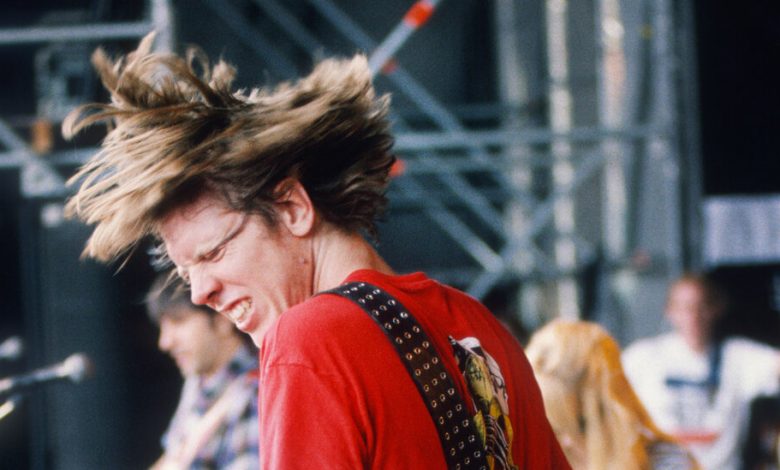Thurston Moore Revisits His Sonic Youth

SONIC LIFE: A Memoir, by Thurston Moore
The loudest summoning gong in pop culture history, if dozens of rock memoirs can be believed, was struck on Sept. 9, 1956. That is when Elvis performed on “The Ed Sullivan Show.” But time passed. Patti Smith’s revelatory moment came eight years later, when she saw the Rolling Stones on Sullivan. The band made her feel she was “trapped in a field of hot dots.” The music gave her a funny feeling, she wrote, in her pants.
For Thurston Moore, a driving force in the important art-noise band Sonic Youth, the epiphany was “Louie Louie,” the indecipherable-at-any-speed single by the Kingsmen. Moore’s older brother brought a copy home in the summer of 1963, when Moore was 5. They played it all day. “The lead singer’s voice had the air of a boy smoking a cigarette with one hand while banging a tambourine in the other, an insolent distance to his delivery, a vision of being at once boss and bored,” Moore writes in his vivid new memoir, “Sonic Life.”
Insolent, boss, bored — this became Moore’s persona, too. Especially boss. Maybe you caught Sonic Youth live during its heyday, roughly 1986 to 2003. I did once, near the end, in New York City. They were better than merely good. The amps were so loud, as earsplitting as gunfire, that I felt my heart adjust. Sonic Youth had a slashing, open-stroke sound that could go all heavy and woozy. The drums sounded like a whip’s crack, or the crack of doom. Tall and thin, hair flopping down over his eyes like a Skye terrier, sometimes dressed in long untucked Oxford shirts, Moore was an unusual rock luminary. He resembled a clean-cut Yalie who on his way to a cappella practice had taken an exceptionally wrong turn in his Volvo.
Moore didn’t go to college — at least, not for more than a semester. He grew up in South Miami, Fla., and then in Bethel, Conn. His father, who died after brain surgery when Moore was in his teens, taught art and philosophy at Western Connecticut State College. The family wasn’t wealthy, but there were books and paintings in the house. Moore was a mediocre student, and he got into trouble. His mother was humiliated when he was arrested and got his name in the local paper for robbing the house next door with a deadbeat friend. He writes that he took a Joni Mitchell record.
The first 150 or so pages of “Sonic Life” describe this childhood and his early years in downtown Manhattan. Mostly, though, the opening chapters are about his listening habits — his discovery of bands like Iggy and the Stooges, the Ramones and Captain Beefheart. Autobiography dissolves almost completely into discography. This section is too long and impersonal, and I might have put the book down if I weren’t getting paid to keep going. His voice can sound canned: “With growing economic disparity, street crime was a normalized part of daily life.”
But the book gets much better. Moore was in the audience for a lot of crucial shows at CBGB, which “felt like entering some kind of witch’s house,” and the Mudd Club and Max’s Kansas City. He tugged on Patti Smith’s ankle and flipped Dee Snider the bird. “I was notorious all the way home that night,” he writes.
He was learning to play guitar, and he would appear on these stages. He had a look he calls “neo-bumpkin.” He appraises the talent in the room: “Blondie was the rare act that could chew bubble gum while reading ‘Naked Lunch.’”
This memoir finds its room tone when he meets Kim Gordon, with whom he founded, along with the guitarist Lee Ranaldo, Sonic Youth in 1981. Thurston and Kim. They were beautiful, cool and gifted — the Ken and Barbie, the Nick and Nora, the Bonnie and Clyde of post-punk downtown Manhattan. It’s a terrific love story. There is a lot of running around on glittering and gritty streets, holding hands, wheat-pasting concert fliers onto walls. They had a bathtub in the kitchen. He’d throw keys down to visitors in a sock. When they met, he had adopted a grocery store cat named Sweetface and she had a dog named Egan. I fretted about Sweetface and Egan all through “Sonic Life.” Thurston and Kim were constantly hopping into vans, and later limousines and airplanes, and leaving poor Sweetface and Egan with some pretty scruffy music dudes.
Color Xerox machines! Moore recalls their advent, and how artists (including Jean-Michel Basquiat and Keith Haring) and bands lined up to print fliers, announcements, manifestos, zines. The copy shop, as much as any club, was a forum for heady social interaction.
When Thurston and Kim announced their split, in 2011, it was a big deal. He’d met someone else, an art book editor. Gordon describes the awfulness, and the heartbreak, more fully in her similarly excellent memoir, “Girl in a Band” (2015).
They had a long run. Sonic Youth spent many years on the road, touring in vans, before finding critical success with their fifth album, “Daydream Nation,” which appeared in 1988. The Sonic Youth song I’ll never tire of is the sinister and simmering “Death Valley ’69,” from an earlier record.
They describe their early tours as a nonstop, take-no-prisoners “war with the soundpeople of America,” who would rarely let them play as loudly as they wanted, lest the sound equipment burst into flame. Moore played so aggressively that he was always cutting his fingers, and splashing blood around the stage. Van life sucks when you’re 6-foot-6, as Moore is.
One reason Moore is a good observer of the early years is that he’s a good observer of other people, always a good sign in a memoirist. Here he is, for example, on Walter Sear and Roberta Findlay, the owners of Sear Sound, a Midtown recording studio, where Sonic Youth recorded the 1987 album “Sister”:
Nirvana opened for Sonic Youth, as did Babes in Toyland, River Phoenix’s band and Sleater-Kinney. The band was invited on tour with Neil Young, a mixed experience. They co-headlined Lollapalooza in 1995 with Courtney Love’s band, Hole, after Gordon produced Hole’s first major-label release. They signed with an imprint of Geffen, a recording giant, to the distress of some fans. They appeared on “Late Show With David Letterman,” maybe inspiring the next Patti Smith. They threw an impromptu, star-studded party in a suite at the Chateau Marmont, after which Moore says he got a $40,000 room tab, not including fumigation and cleaning.
Moore admits he was a moody jerk sometimes. If he and Ranaldo had a falling out, I’m not aware of it. But Ranaldo barely appears in this book. The band stuck around long enough that they became almost parental figures, part of the establishment, to many bands. People began to snicker at the word “youth” in their name.
Moore and Gordon have a grown daughter, Coco. When she was little, she said after a band practice, “Noise is only really good if you’re the one making it.” I bet Sweetface and Egan agreed.
SONIC LIFE: A Memoir | By Thurston Moore | Doubleday | 468 pp. | $35




